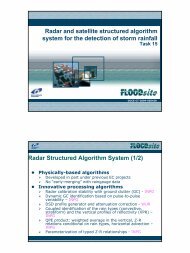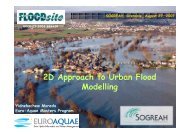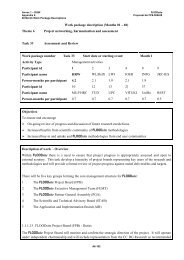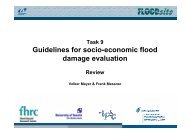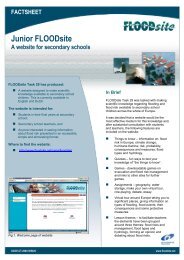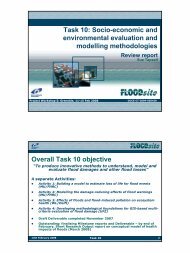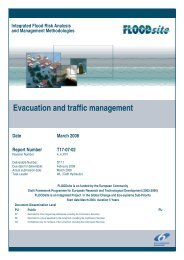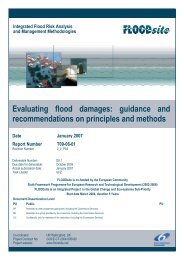Language of Risk - FLOODsite
Language of Risk - FLOODsite
Language of Risk - FLOODsite
You also want an ePaper? Increase the reach of your titles
YUMPU automatically turns print PDFs into web optimized ePapers that Google loves.
<strong>FLOODsite</strong> <strong>Language</strong> <strong>of</strong> <strong>Risk</strong> 2 nd Ed.<br />
Contract No:GOCE-CT-2004-505420<br />
factor and its “true” value. Understanding this uncertainty within our predictions and decisions is at<br />
the heart <strong>of</strong> understanding risk. Within uncertainty we are able to identify:<br />
• knowledge uncertainty arising from our lack <strong>of</strong> knowledge <strong>of</strong> the behaviour <strong>of</strong> the physical<br />
world. This is also referred to as: epistemic, functional, internal, or subjective uncertainty or as<br />
incompleteness<br />
• natural variability arising from the inherent variability <strong>of</strong> the real world. This is also referred<br />
to as: aleatory, external, inherent, objective, random, stochastic, irreducible, fundamental, or<br />
“real world” uncertainty<br />
• decision uncertainty reflecting complexity in social and organisational values and objectives.<br />
The uncertainties in simulation modelling as used in flood risk management are principally due to<br />
natural variability and knowledge uncertainty. There are a number <strong>of</strong> contributors to these<br />
uncertainties that can be considered separately, HR Wallingford (2002). However, this classification<br />
is not rigid or unique. For example, uncertainty on weather or climate will be taken as “natural<br />
variability” within flood risk management but as “knowledge uncertainty” in the context <strong>of</strong> climate<br />
simulation.<br />
It is important to recognise the differences between accuracy, precision, error and uncertainty.<br />
Accuracy precision and error differ from uncertainty as defined above but limitations in accuracy,<br />
precision or the possibility for human error will contribute to the overall uncertainty.<br />
• Accuracy – can be defined as the closeness to reality. For example, “the crest level <strong>of</strong> a flood<br />
defence is between 3m and 4m above datum”, is an accurate statement for a defence crest level<br />
<strong>of</strong> 3.5m above datum.<br />
• Precision – can be regarded as the degree <strong>of</strong> exactness, regardless <strong>of</strong> accuracy. For example,<br />
“the crest level <strong>of</strong> a defence is 2.456m above datum”, is a precise statement. If however, the<br />
crest level is actually 3.5m above datum, the statement is not accurate.<br />
• Errors – are mistaken calculations or measurements with quantifiable and predictable<br />
differences, such as errors within datum measurements.<br />
3.6.2 Uncertainty in a Social Science context<br />
The following concepts were identified within the project team working within <strong>FLOODsite</strong> Theme<br />
1.3 – Vulnerability<br />
Issue Discussion<br />
Ignorance This includes all the different sorts <strong>of</strong> gaps in our knowledge which cannot be<br />
addressed (or even recognised) within the present status <strong>of</strong> knowledge and<br />
understanding. This ignorance may merely be <strong>of</strong> what is significant, such as<br />
when anomalies in experiments are discounted or neglected, or it may be deeper,<br />
Indeterminacy<br />
Institutional<br />
uncertainty<br />
as is appreciated retrospectively when revolutionary new advances are made.<br />
This is a category <strong>of</strong> uncertainty which refers to the open-endedness (both social<br />
and natural) in the processes <strong>of</strong> environmental damage caused by human<br />
intervention. It applies to processes where the outcome cannot (or only partly) be<br />
determined from the input. Indeterminacy introduces the idea that contingent<br />
social behaviour also has to be included in the analytical and prescriptive<br />
framework. It acknowledges the fact that many knowledge claims are not fully<br />
determined by empirical observations but are based on a mixture <strong>of</strong> observation<br />
and interpretation<br />
This refers to inadequate collaboration and/or trust among institutions (agencies<br />
in particular), due to poor communication, lack <strong>of</strong> understanding, overall<br />
bureaucratic culture, conflicting sub-cultures, traditions and missions.<br />
Legal uncertainty This refers to the possibility <strong>of</strong> future liability for actions or inactions. The<br />
absence <strong>of</strong> undisputed legal norms strongly affects the relevant actors’ decisions.<br />
T32_04_01_ <strong>FLOODsite</strong>_<strong>Language</strong>_<strong>of</strong>_<strong>Risk</strong>_D32_2_v5_2_P1 30 April 2009<br />
10



